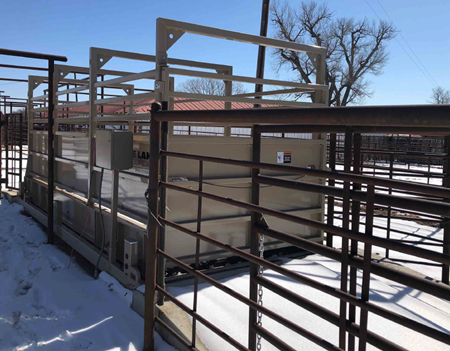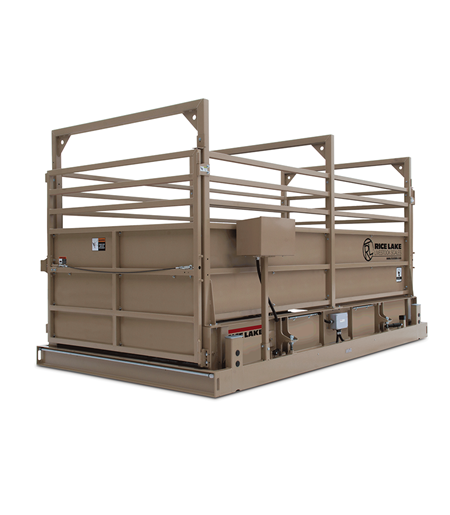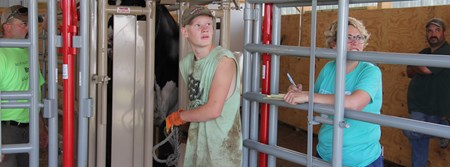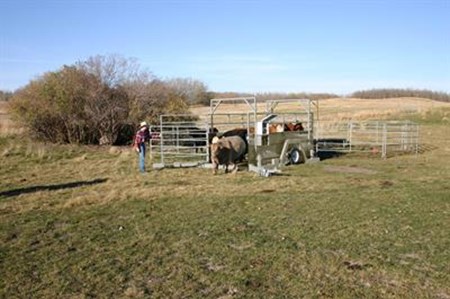Is the website displaying in the correct language? Please confirm or select a different language.
Your region has been set automatically. Please confirm or select a different region.
Smith Oasis Cattle Benefits from Onsite Weighing
Rice Lake Weighing Systems' MAS-LC stationary livestock scales have increased safety and maximized profits for this Texas ranch.
Publish Date: 04/16/2021
Weighing cattle on a reliable, certified scale is essential to monitor animal growth and determine profits at the time of sale. For many ranchers, offsite weighing is the established, traditional process of selling cattle. However, onsite livestock scales offer the powerful benefits of maximizing profits and minimizing animal stress.
When Currie Smith, owner and operator of Smith Oasis Cattle in Hemphill County, Texas, wanted to add a new livestock scale to his ranch, several factors led his decision-making process in the search for the best equipment: safety, accuracy and durability. He considered several different manufacturers but ultimately chose Rice Lake Weighing Systems’ MAS-LC stationary livestock scales for their safety features, reliable performance and superior build quality. With the addition of the MAS-LC, Smith Oasis uses a total of four scales to weigh cattle. “The MAS-LC is hands-down better than the two beam-type scales we use and the other electronic scale,” Currie states.
Safety is Key
“Above all else is the safety of our cattle and operators,” Currie explains. “When we’re weighing, I need to be confident when the gate is closed, it will stay closed and not add more stress. The flooring is more stable and less slick.”
The MAS-LC uses a heavy-duty latch assembly and 48-inch, 11-gauge steel kick panels on side walls and gates to prioritize operator protection. It also includes a unique floor design feature to minimize the risk of animal injury. It is not uncommon for cattle to slip on dirty platforms when they are being weighed, which is why Rice Lake’s livestock scales use recycled plastic and rubber material in a tread-optimized pattern (X-Lug or X-Plank) to provide superior traction. Along with improved animal safety, this unique flooring material does not rot or harbor moisture, and is simple to maintain. “I really appreciate that it’s easy to clean out,” Currie adds. “We recently installed Rice Lake’s flooring system to replace a wooden floor on one of our old beam-type scales. I am sure the new flooring will outlast the original scale at this leased ranch property.”
Profits of Accuracy
Weighing cattle offsite does not produce favorable results for the seller. Transporting cattle subjects the animals to a tremendous amount of stress, during which they lose weight. This weight loss is known as “shrink” which is a term most ranchers know all too well, as the buyer typically agrees to a predetermined shrink percentage before weighing the cattle.
Additionally, fuel consumption is not accounted for when weighing offsite. The truck will be weighed before visiting the ranch to acquire its tare value, then burn fuel by driving to the ranch and back to the scale with a full load of cattle. Although the truck now weighs less due to the amount of fuel used, its previously acquired tare is used to calculate the sale.
Weighing cattle onsite with a reliable livestock scale ensures a more accurate and “true” weighment by eliminating the guesswork of shrink. The added convenience of printing a Legal for Trade sale ticket means Currie can complete weighments on his own time without relying on any external personnel.
By purchasing the MAS-LC, Currie has seen a quick return on his investment. “The scale will pay for itself pretty quickly,” explains Currie. “I can’t imagine ever weighing offsite again.”
Durability Matters
It takes an extraordinary scale to withstand the unique conditions of livestock weighing. Exposure to unpredictable animals as well as the elements of Mother Nature warrants an extreme-duty scale. “I determined Rice Lake’s livestock scale was much better than the competition. It’s solid, made the right way. That’s important to me.”
The MAS-LC uses steel I-beam construction typically found in truck scales, 3-inch square tubing for sectional uprights and 2-inch horizontal square wall tubing connecting the uprights. Its shipping weight speaks for itself as one of the heaviest in its class with a weighbridge built to last a generation or longer.
Currie also enjoys the MAS-LC’s portability. “I like that I can move the scale. It’s not permanent so I can relocate if necessary. It balances very easily and is quick to re-certify if I do move the scale.”
There used to be a time when only large ranches had onsite scales. Now, operations of any size, even smaller ranches that sell a few loads of cattle per year, are seeing the rewards. With the long-term price of beef predicted to rise, producers are no longer asking whether they can afford an onsite livestock scale—rather, they must consider the cost of not having one. For Currie, the impact was clear and he is ready for the years ahead.
Subscribe to Rice Lake Magazine
Sign in or create a Rice Lake website account to request a Rice Lake Magazine filled with application stories like this one be sent to you.
Account Sign In Create an Account


 My Account
My Account



